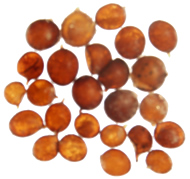A tantalizing press release says Bolivia earned $155 million from biodiversity-based products, and wants to up that amount.
Potato pest heads west
 Globodera pallida cysts. Cysts are the egg-engorged bodies of dead female nematodes. Eventually, the cysts dislodge from a plant root and the eggs hatch. Image courtesy Zafar Handoo, ARS.
Globodera pallida cysts. Cysts are the egg-engorged bodies of dead female nematodes. Eventually, the cysts dislodge from a plant root and the eggs hatch. Image courtesy Zafar Handoo, ARS.
American agricultural scientists have confirmed the presence of the pale potato cyst nematode (Globera pallida) in soil in Idaho. This is the first time it has been reported in the US, although it has been in Canada for at least a year. The report from USDA makes much of the skilled science needed to distinguish G. pallida from a close relative, the tobacco cyst nematode, (G. tabacum), and we applaud that. What it doesn’t say is that economic losses amount to roughly 2 tonnes per hectare for every 20 eggs per gram of soil. Total losses can approach 80% in the case of heavy infestations. the main means of control is to grow resistant varieties. In the UK this resulted in the rise of Maris Piper, a potato that, in my opinion, is little better than wet blotting paper.
Marine genetic resources
More on marine genetic resources, from Earth Negotiations Bulletin.
Access and benefit sharing in Namibia
Roundup on the status of access and benefit sharing legislation in Namibia.
Ugandan discussions
Ugandan minister of Agriculture Hilary Onek has been talking to Chinese officials about increased Chinese investment in modernizing Uganda’s agriculture. Onek’s main desire seems to be to increase the use of fertilizers and certain types of high-yielding seed. It sounds like the same old same old, with no thought for either traditional smallholder expertise or their approach to new technology. But maybe all that hi-tech investment really is what Uganda and China need.